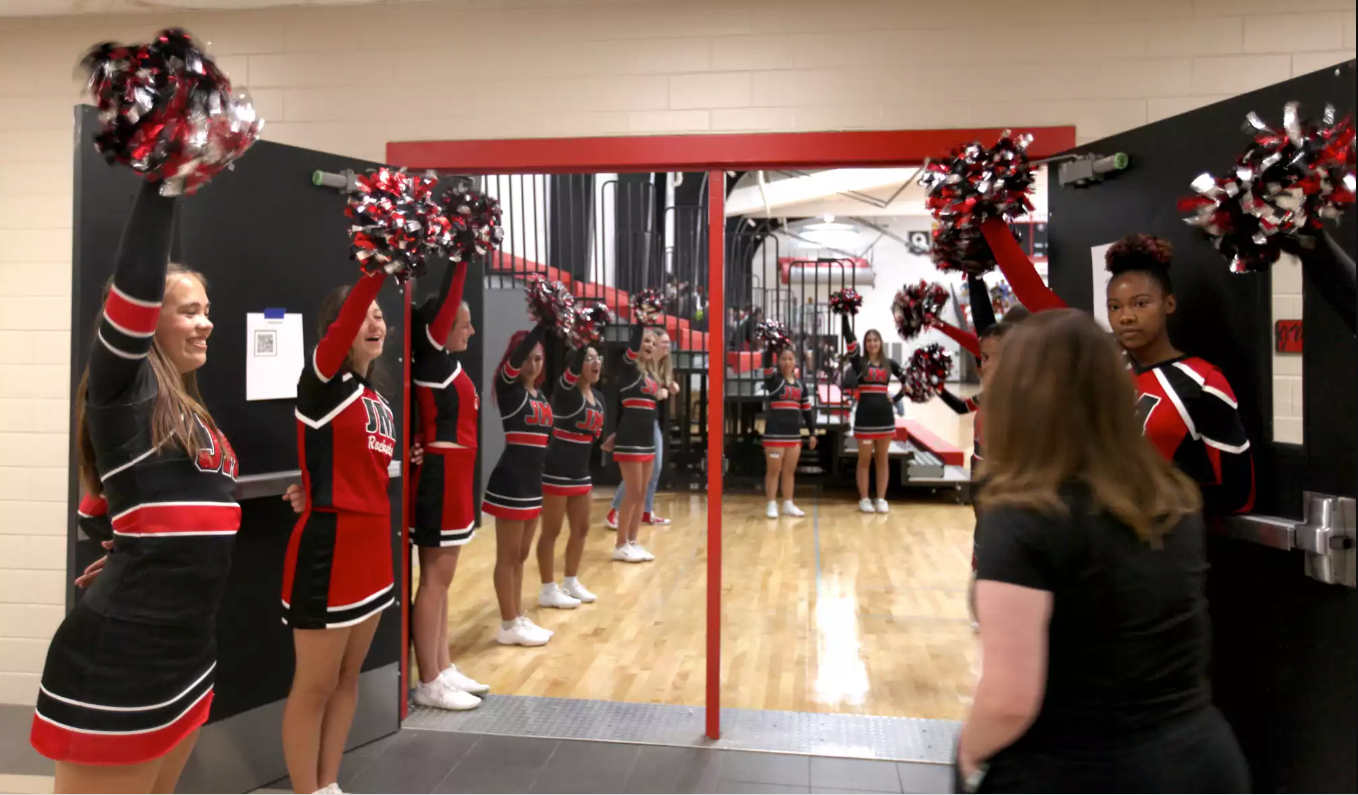Pandemic experience shows new ways to make kids feel welcome at school
Published 5:36 pm Tuesday, September 6, 2022

- The John Marshall High School cheer team welcomes incoming freshmen before a pep rally at the school in Rochester on Aug. 23. Tuesday marked the first official day of school. Elizabeth Nida Obert for MPR News
|
Getting your Trinity Audio player ready...
|
By Catharine Richert, Minnesota Public Radio News
On a recent late August day, buses filled with new students and incoming freshman arrived at John Marshall High School in Rochester for a three-day welcoming event — weeks before classes started.
Activities included team-building exercises, a tour of the building and learning the school fight song.
Even some upperclassmen joined in on the event, including student body president Manasa Yerriboyina.
“COVID was hard for a lot of students and teachers because it really took a lot out of us,” she said as she passed out name tags to new students. “To get together brings us closer as a family and it motivates us at the end of the day to do what we’re here to do: be a family and learn.”
Creating an early sense of connection is by design, one aimed at improving the mental health of students who’ve had a rough few years.
The Rochester trend tracks with a statewide study conducted by the University of Minnesota, which found that by the start of the 2021 school year, more than 71 percent of teachers and half the students polled said they were worried about their mental well-being.
Events at John Marshall are part of a broader districtwide strategy to limit defiance and disengagement among students in the coming school year — behaviors school officials say emerged in spades after students returned from pandemic-related distance learning.
“I would say it was definitely predictable, but still very surprising,” said John Marshall Principal Matt Ruzek. “I’m reluctant to say we saw an increase in [bad] behavior, I think what we saw was just a cry for belonging and social connection.”
‘Kids just weren’t going to class’
School district data shows that while disciplinary infractions were on par with the school year leading up to the pandemic, staff reported more kids engaging in defiant behavior, and more often. A deeper dive into that data shows that students of all ages felt less connected to their schools — and less understood by their teachers.
“I think it’s avoidance behavior,” said Chief of Schools Jacque Peterson, who’s been leading a districtwide effort to help create a sense of community in Rochester’s schools.
She said for some students, virtual learning created an environment where they could turn their attention away from learning. When they headed back to in-person learning, some were behind on their learning.
“I think it doesn’t take much to imagine, like, I’m sitting in a classroom and I have no idea what the teacher is talking about. It’s easier to just detach than it is to try to figure it out,” she said.
For Angi McAndrews, principal of Kellogg Middle School, those behaviors were front and center when kids came back to in-person learning in the spring of 2021.
“We had definitely over the last year had more kids that were just refusing to go to class,” she said. “It would be third hour, our hallways should be empty, kids should be learning and we just had kids that just weren’t going to class.”
McAndrews says the behaviors — and their frequency — were baffling and complex, emblematic of the mental health struggles so many kids faced during distance learning.
She says COVID mitigation measures made school weird. Some students didn’t understand expectations after learning online for so long from home.
Adding to the challenge: She and her staff hardly knew some of the students after a year of virtual learning.
“Trying to build the relationship at the same time as holding kids accountable for behavior is really super challenging, because we want to make sure that kids feel safe and connected and welcome,” she said. “But we also want to make sure that they’re here and that we’re there focusing on what we’re here for, which is education.”
‘Has anyone asked the kids?’
School district administrators were getting an ‘S.O.S’ from school leaders, said Will Ruffin II, equity and engagement director for Rochester Public Schools.
“We were in a cabinet meeting and then I said something like, ‘Has anyone asked the kids?’” he said.
They hadn’t, so they did.
Last school year, Ruffin organized nearly 40 listening sessions with students from across grade levels and demographic groups who had been disciplined about why they were engaging in inappropriate behavior.
Some of the students’ answers were surprising, Ruffin said.
“They felt the teacher embarrassed them in front of everyone or made an example out of them,” he said. “So therefore they didn’t want to go.”
For Ruffin, the survey results showed that students — and teachers — weren’t doing well.
“So where we may think our students weren’t handling their side of the bargain, I think maybe the patience of some of our adults wore thin,” he said.
With a new school year starting, the listening sessions have inspired changes, said Peterson. For instance, Rochester students will see more school-based extracurriculars. A new cell phone policy sets clearer expectations around when they can be used in school.
But as the fall approaches, Peterson said the focus is on building relationships so it’s easier for students to follow rules, and easier for staff to discipline them when they don’t.
“Until kids feel a sense of belonging, you’re not going to really see an impact on student achievement or really behavior,” she said.




